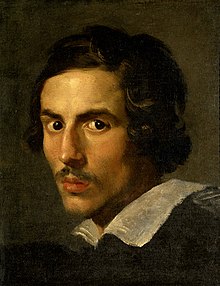Gian Lorenzo Bernini
| Gian Lorenzo Bernini | |
|---|---|

Self-portrait of Bernini, c. 1623
|
|
| Born |
Gian Lorenzo Bernini 7 December 1598 Naples, Kingdom of Naples, in present-day Italy |
| Died | 28 November 1680 (aged 81) Rome, Papal States, in present-day Italy |
| Nationality | Italian |
| Known for | Sculpture, painting, architecture |
| Notable work | David, Apollo and Daphne, The Rape of Proserpina, Ecstasy of Saint Theresa |
| Movement | Baroque style |
Gian Lorenzo Bernini (Italian pronunciation: [ˈdʒan loˈrɛntso berˈniːni]; also Gianlorenzo or Giovanni Lorenzo; 7 December 1598 – 28 November 1680) was an Italian sculptor and architect. While a major figure in the world of architecture, he was the leading sculptor of his age, credited with creating the Baroque style of sculpture. As one scholar has commented, "What Shakespeare is to drama, Bernini may be to sculpture: the first pan-European sculptor whose name is instantaneously identifiable with a particular manner and vision, and whose influence was inordinately powerful...." In addition, he was a painter (mostly small canvases in oil) and a man of the theater: he wrote, directed and acted in plays (mostly Carnival satires), also designing stage sets and theatrical machinery, as well as a wide variety of decorative art objects including lamps, tables, mirrors, and even coaches. As architect and city planner, he designed both secular buildings and churches and chapels, as well as massive works combining both architecture and sculpture, especially elaborate public fountains and funerary monuments and a whole series of temporary structures (in stucco and wood) for funerals and festivals.
Bernini possessed the ability to depict dramatic narratives with characters showing intense psychological states, but also to organize large-scale sculptural works which convey a magnificent grandeur. His skill in manipulating marble ensured that he would be considered a worthy successor of Michelangelo, far outshining other sculptors of his generation, including his rivals, François Duquesnoy and Alessandro Algardi. His talent extended beyond the confines of sculpture to a consideration of the setting in which it would be situated; his ability to synthesize sculpture, painting, and architecture into a coherent conceptual and visual whole has been termed by the art historian Irving Lavin the "unity of the visual arts". In addition, a deeply religious man, working in Counter Reformation Rome, Bernini used light both as an important theatrical and metaphorical device in his religious settings, often using hidden light sources that could intensify the focus of religious worship or enhance the dramatic moment of a sculptural narrative.
...
Wikipedia
